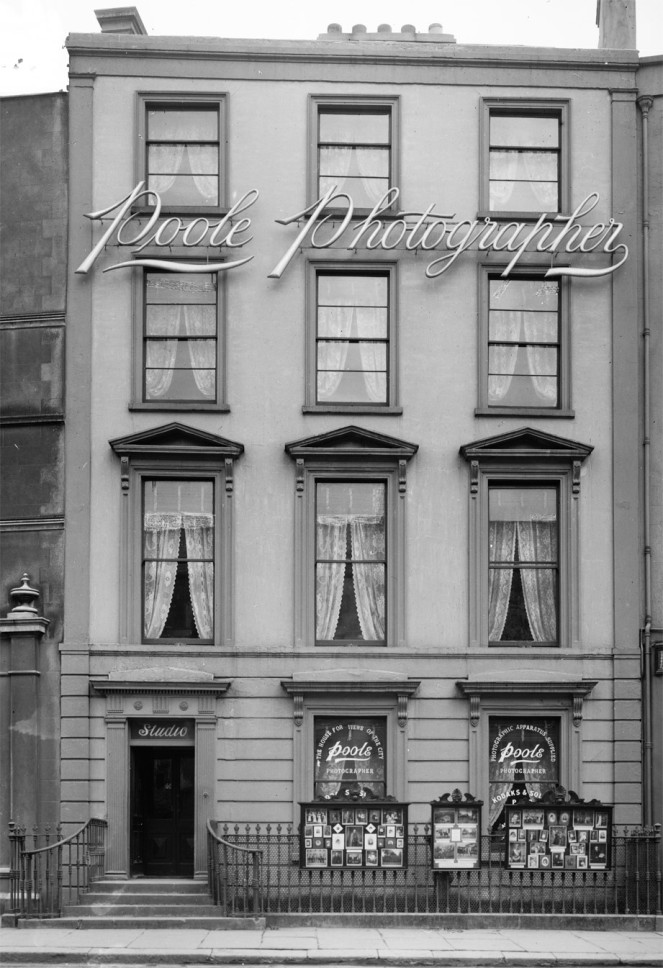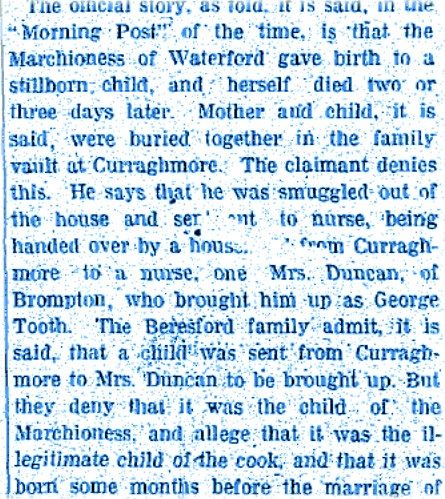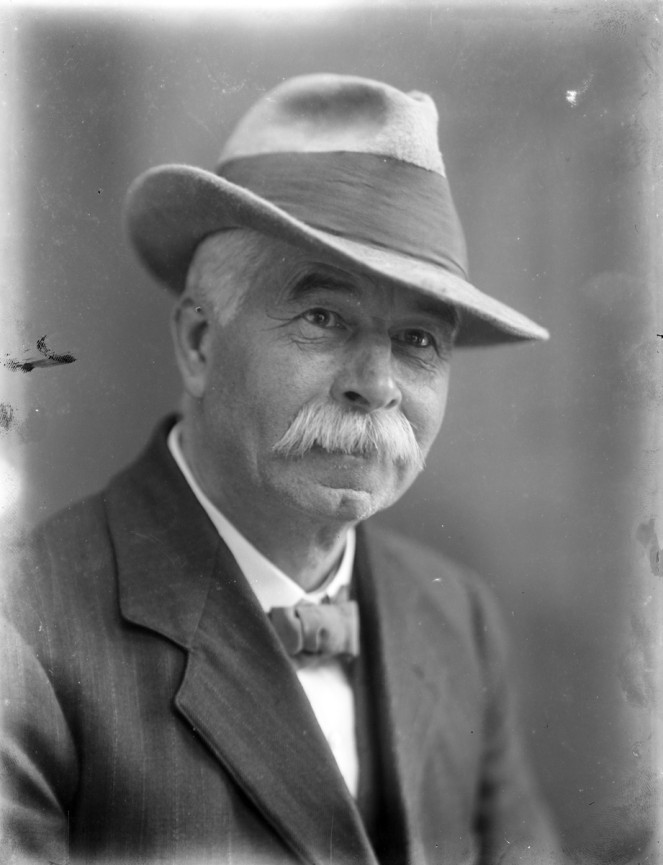by Margaret O’Brien Moran, PhD researcher
I am a postgraduate researcher in the Centre for Media Research at the University of Ulster, Coleraine. Through an historical inquiry into the Poole Photographic Collection at the National Photographic Archive, my study considers the importance of the physical photograph and the impact of digitisation.
The Poole Photographic Collection is one of the largest collections of early Irish photography held by the National Library of Ireland. This extensive collection, produced at A.H. Poole's photographic studios in Waterford between 1884 and 1954, consists of c. 65,000 original glass plate negatives and provides images of the social and economic life of the south-east of Ireland during this period.

Photographic Studios of Messrs. A.H. Poole at 34 The Mall, Waterford. NLI ref. PWP2027
In addition to the glass plates the Poole Photographic Collection includes nine large boxes and twenty-seven small boxes of original Poole prints. It is this material archive which forms the basis of my project. Box D19289–D19438 which is the first of the large boxes that I have examined, contains an assortment of photographs both in size and subject matter. So far the work undertaken has involved separating and sorting the photographic prints according to categories and locations and recording the notation on the verso of the prints. Snippets of information from late 19th and early 20th century Irish society weddings, engagements, the hunt or a visit by royalty provide a background to the photographs – without which the cultural significance remains obscure.
This box D19289 – D19438 contains quite a number of photographs of Curraghmore Estate, which is situated about 14km north-west of Waterford City and has been the home of the Marquess of Waterford and his ancestors since 1170. One of the first Curraghmore photographs I came across was of a beautiful and evocative memorial sculpture of Florence Grosvenor, wife of the 5th Marquess of Waterford. According to the notation on the verso of the photograph this was a “Monument placed by the 5th Marquess of Waterford in the family burial place, Clonegam Church, Curraghmore Demesne, of his first wife with her still-born child”. However, the heading of the notation on the back states, “Waterford Title Disputed” and continues “The claimant to the title, story is that there was no still-born child, but that he is that child, and was handed over by a maid to a Mrs. Duncan who brought him up under the name of George Tooth”. This simple statement connects the material evidence, which is the photograph, to an historically-situated event.

Photographic print from the Poole Photographic Collection of the funerary monument to Florence Grosvenor, wife of the 5th Marquess of Waterford, and her child. NLI ref. Box D19289-D19438
Research has revealed that John Henry De la Poer Beresford, the 5th Marquess of Waterford, married Florence Grosvenor Rowley in 1872. Having given birth to a still-born child on 27 March 1873, Lady Waterford’s health declined and she died on the 4th of April of that year. Lord Waterford married for a second time on 21 July 1874. He married Lady Blanche Somerset, the daughter of Henry Somerset, the 8th Duke of Beaufort. Lord Waterford and his second wife had four children, three daughters and one son. On the death of his father in 1895, Henry De la Poer Beresford succeeded his father as the 6th Marquess of Waterford.

Verso of photographic print from the Poole Photographic Collection of the funerary monument to Florence Grosvenor, Wife of the 5th Marquess of Waterford. NLI ref. Box D19289-D19438
On 13 November 1917, the Times published an article entitled “A Gardeners claim to a peerage” concerning a case which had come before the Court of Appeal. The action was brought by George Tooth under the Legitimacy Declaration Act 1858, seeking to establish that he was the son of the 5th Marquess of Waterford and his first wife Florence Grosvenor. Lord Waterford on the other hand, claimed that his wife gave birth to a still-born child on 27 March 1873, and that on 4 April 1873, Lady Waterford died and she and the child were buried together.
It appears that early in 1872, Lady Waterford spent a few weeks at a Franciscan Convent in London. While there, she heard from her maid and companion Mrs. White, that the cook’s sister Georgina Tooth had given birth to a child in the Holborn Union Workhouse; and had died shortly afterwards. In the nineteenth century, people ended up in the workhouse for a variety of reasons. Although workhouses were not prisons, and entry was generally on a voluntary basis, for many unmarried pregnant women who were disowned by their families, the workhouse was the only place they could go during and after the birth of their child. Out of sympathy, Lady Waterford, had arranged for the child to be taken from the workhouse and on 21 February 1872 that boy was christened George Tooth (after his mother Georgina). Lady Waterford also organised George Tooth's care and education, which was continued by Lord Waterford after her death.

From the Munster Express on Saturday, 2 August 1913
Around 1893, George Tooth (who was now aged 21) began to make statements alleging that he was the purported still-born child of Lord and Lady Waterford, however due to lack of funds he could not bring his case to court. It appears that George had written to Lord Waterford on several occasions. In one correspondence dated 1895, Lord Waterford stated that he had started George in life but that he must look after himself in the future. As the only people who knew the details of the matter were getting old, an action was instigated to “perpetuate testimony”. The chief witnesses were Mrs Pricella White, who in 1873 had been a maid companion to Lady Waterford and had been involved in taking the child from the workhouse; and Mrs Price, a personal friend of Lady Waterford who was with her at the times in question. In July 1913, due to an order made by George Tooth, the witnesses were cross-examined in London before one of the examiners of the Court. On 31 March 1914, Tooth began an action for slander against Mrs White (the maid companion) for stating that Tooth was not the Marquess of Waterford. The case went to the Court of Appeal and was eventually dismissed. Nevertheless on the day that the appeal was dismissed, George Tooth began to send abusive letters and post cards to Mrs White. On 15 June 1914, he sent her three post cards, in which he accused her of being a liar and of being involved in a conspiracy against him. Tooth also accused Mrs White of being a murderess! Tooth was subsequently arrested and tried at the Old Bailey. Having pleaded guilty and apologised, he was released and bound over to keep the peace.
However in January 1917 an application was made to publish the evidence given by the witnesses. Permission was duly granted. It was argued that this evidence should be allowed to be used at the trial of this case, which was pending. Both of the witnesses were now quite old and Mrs White was unwilling to subject herself to the possibility of further attacks by Tooth. A long drawn out trial, lasting one hundred and three days ensued, and on 2 February 1918 the Times published the following:
“The Waterford Peerage
The gardener named Tooth, who claimed the Waterford peerage has lost his case, and he cannot have the satisfaction of knowing that the result leaves the slightest doubt in the mind of any reasonable person. It is hard to believe how he found anyone to support his impudent pretensions. ... Tooth's case was clumsy, variable and tenuous. It never had in it the romantic allegations which marked the effort of an organ grinder to obtain the Poulett earldom in 1903, or the claim to the Sackville barony in 1910. It needed no reply, and none would have been given but for the wise desire of the Waterford family to allay once and for all the foolish gossip to which TOOTH and a female busybody who encouraged him had given currency.”
Therefore, from the hand-written annotation on the Poole photograph of Florence Grosvenor's funerary monument, it is possible to understand the context in which the photograph was taken and recognise its cultural significance. A.H. (Arthur Henri) Poole, as I have discovered, was a member of the Press Picture Agency of London which would suggest that the photograph discussed here was for publication. Due to the materiality of the photograph – an historical object handled, annotated and stamped at the time it was produced – we are able to glean additional information which could not be derived from the image alone; thus highlighting the importance of photographs as physical artifacts.

Photographer Arthur Henri Poole. NLI ref. PWP2929a
The PhD I am undertaking is practice-based which means that as well as a written thesis, I must produce a body of practical work which develops and contributes to the overall research. Following on from the research I carried out on the Poole photographic prints at the National Photographic Archive, I applied for and secured an ArtLinks 2012 Bursary Award from Waterford County Council. That funding will support the production of an interactive web interface which will indicate the areas in Ireland and England where the Poole firm operated. From the notation on the verso of the photographic prints it is evident that A.H. Poole's firm operated extensively throughout Ireland and parts of England; photographing a variety of social occasions. The aim is to create links from the indicated locations to pages of photographs of these events, with accompanying information obtained from the verso of the photographs. This will form part of the practice-based element of the research; highlight the importance of the material archive; and help determine the significance of the Poole Photographic Firm. It is envisaged that this website will be utilised by the National Photographic Archive, and Museums and Arts Centres throughout the country, in particular in the Waterford area.
